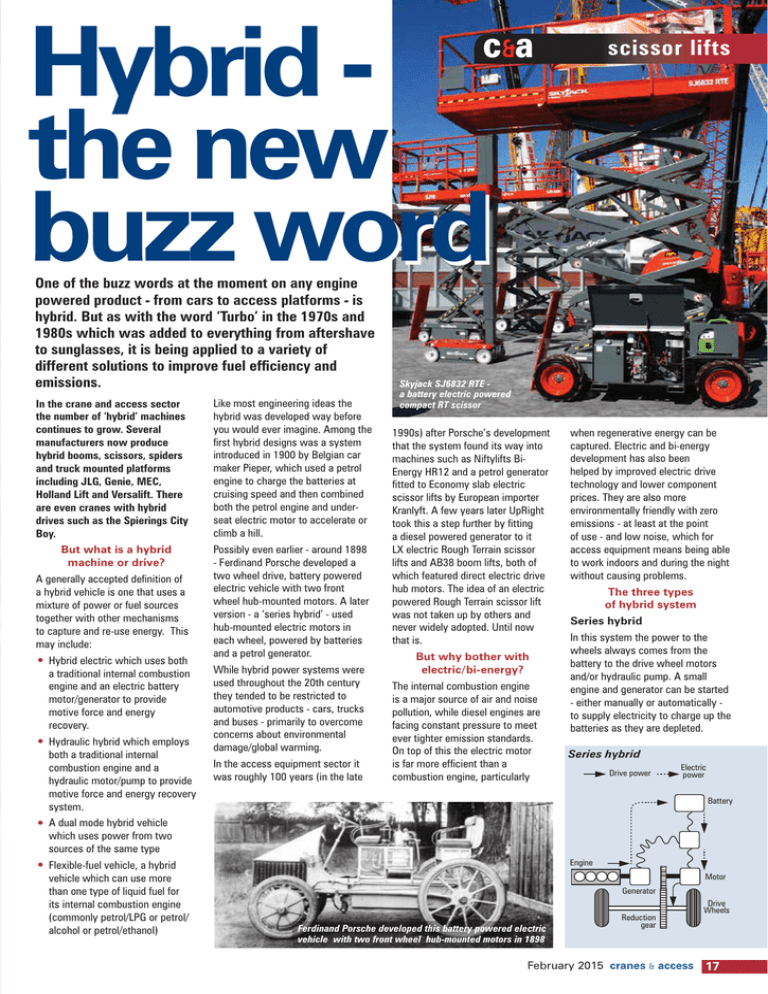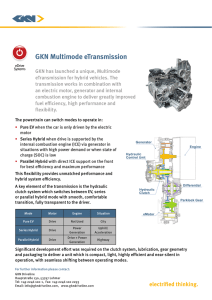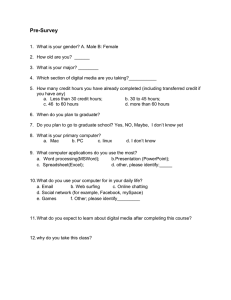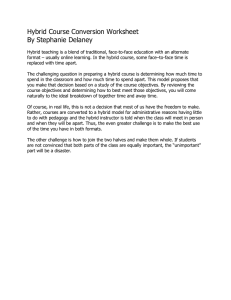Hybrid - Skyjack
advertisement

Hybrid the new buzz word c&a One of the buzz words at the moment on any engine powered product - from cars to access platforms - is hybrid. But as with the word ‘Turbo’ in the 1970s and 1980s which was added to everything from aftershave to sunglasses, it is being applied to a variety of different solutions to improve fuel efficiency and emissions. In the crane and access sector the number of ‘hybrid’ machines continues to grow. Several manufacturers now produce hybrid booms, scissors, spiders and truck mounted platforms including JLG, Genie, MEC, Holland Lift and Versalift. There are even cranes with hybrid drives such as the Spierings City Boy. But what is a hybrid machine or drive? A generally accepted definition of a hybrid vehicle is one that uses a mixture of power or fuel sources together with other mechanisms to capture and re-use energy. This may include: • H ybrid electric which uses both a traditional internal combustion engine and an electric battery motor/generator to provide motive force and energy recovery. • H ydraulic hybrid which employs both a traditional internal combustion engine and a hydraulic motor/pump to provide motive force and energy recovery system. Like most engineering ideas the hybrid was developed way before you would ever imagine. Among the first hybrid designs was a system introduced in 1900 by Belgian car maker Pieper, which used a petrol engine to charge the batteries at cruising speed and then combined both the petrol engine and underseat electric motor to accelerate or climb a hill. Possibly even earlier - around 1898 - Ferdinand Porsche developed a two wheel drive, battery powered electric vehicle with two front wheel hub-mounted motors. A later version - a ‘series hybrid’ - used hub-mounted electric motors in each wheel, powered by batteries and a petrol generator. While hybrid power systems were used throughout the 20th century they tended to be restricted to automotive products - cars, trucks and buses - primarily to overcome concerns about environmental damage/global warming. In the access equipment sector it was roughly 100 years (in the late scissor lifts Skyjack SJ6832 RTE a battery electric powered compact RT scissor 1990s) after Porsche’s development that the system found its way into machines such as Niftylifts BiEnergy HR12 and a petrol generator fitted to Economy slab electric scissor lifts by European importer Kranlyft. A few years later UpRight took this a step further by fitting a diesel powered generator to it LX electric Rough Terrain scissor lifts and AB38 boom lifts, both of which featured direct electric drive hub motors. The idea of an electric powered Rough Terrain scissor lift was not taken up by others and never widely adopted. Until now that is. But why bother with electric/bi-energy? The internal combustion engine is a major source of air and noise pollution, while diesel engines are facing constant pressure to meet ever tighter emission standards. On top of this the electric motor is far more efficient than a combustion engine, particularly when regenerative energy can be captured. Electric and bi-energy development has also been helped by improved electric drive technology and lower component prices. They are also more environmentally friendly with zero emissions - at least at the point of use - and low noise, which for access equipment means being able to work indoors and during the night without causing problems. The three types of hybrid system Series hybrid In this system the power to the wheels always comes from the battery to the drive wheel motors and/or hydraulic pump. A small engine and generator can be started - either manually or automatically to supply electricity to charge up the batteries as they are depleted. Series hybrid Drive power Electric power Battery • A dual mode hybrid vehicle which uses power from two sources of the same type • F lexible-fuel vehicle, a hybrid vehicle which can use more than one type of liquid fuel for its internal combustion engine (commonly petrol/LPG or petrol/ alcohol or petrol/ethanol) Engine Motor Generator Ferdinand Porsche developed this battery powered electric vehicle with two front wheel hub-mounted motors in 1898 Reduction gear February 2015 cranes & access Drive Wheels 17



